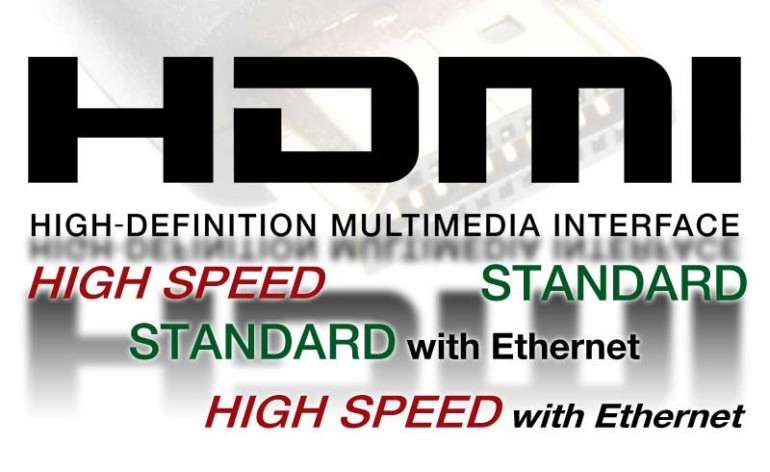HDMI Cable Types – Ethernet and High Speed
When you need a short HDMI cable, your choices may not seem all that difficult. Recently, however, the adoption of some new technologies has made it so that consumers need to pay particular attention to the HDMI cable types they use. A good example of this is in the area of Ethernet support. If you have a newer flat panel television that supports Audio Return Channel and Ethernet support, then your network streaming device (like a connected Blu-ray player, for example) won’t require it’s own Ethernet cable—just the TV. Buy the wrong cable, however, and this feature disappears.
If you’re using an older HDMI cable you also may not be equipped for the latest high speed requirements of 3D signal transmission or 4K (when that becomes more prevalent)
Here is how the current crop of HDMI cable types can be broken down:
HDMI Cable Types
Standard HDMI Cable
These are the “original” HDMI cables. Designed primarily for 720p, 1080i and “short-run” 1080p content, these cables can handle the most basic tasks over lengths of 6 feet or less. A Standard HDMI cable is tested and certified to handle 1080i or 720p video – perfect for transmission of first-gen HD gaming consoles, DVD players, and cableTV and/or satellite TV content.
Standard HDMI Cable with Ethernet
Similar to the above, this cable adds the HDMI Ethernet Channel, a dedicated data channel that let’s you pass network information between the devices. This HDMI Ethernet Channel functionality only works if both of the devices use the proper cable AND are HDMI Ethernet Channel-enabled.
High Speed HDMI Cable
The more recent High Speed HDMI cable was developed to address the fact that signals had progressed to full 1080p resolution (and now beyond with the imminent 4K) and so these new cables are tested to support these new resolutions and bandwidth requirements (4K, 3D, Deep Color, etc). For 3D, Blu-ray Disc players, 4K, and anything that transmits 1080p or higher resolution over 6-9 feet this is the recommended cable.
High Speed HDMI Cable with Ethernet
As with the other “with Ethernet” cable above, this is a High Speed HDMI Cable that supports 1080p video resolution and beyond, but with the addition of the dedicated HDMI Ethernet data channel. Consequently, this cable supports the latest technologies and resolutions being rolled out in today’s networked HD devices. Remember that having this cable doesn’t automatically mean your equipment can pass network information. Rather, HDMI Ethernet Channel functionality only works if both connected devices are HDMI Ethernet Channel-enabled.
[top-seller category_id=’33’ product_count=’4′ title=’Top Selling HDMI Cables’]
Is That It?
In addition to the cable types mentioned above, there’s actually one other HDMI cable type we didn’t yet mention, the Standard Automotive HDMI Cable. This cable supports up to 720p/1080i but doesn’t support HDMI Ethernet Channel or (necessarily) full 1080p. Automotive systems have particular wiring issues that create potential hangup for signal strength. As a result, the Standard Automotive HDMI Cable supports the transmission of stronger signals than other cables types and is tested to these standards.
And, lest we be remiss in mentioning it, this article deals with actual HDMI cable types, not connectors or “features” of HDMI. While a cable may include labels for 3D, 4K and other features, the only certifications for HDMI cable types have to do with High Speed and Ethernet. This is because the Ethernet designation actually represents a physical change within the cable itself. There are wires that are turned into twisted pair Ethernet cables in order to send networking information properly and without fear of signal loss. These four (or five) HDMI cable types will still be available with various HDMI mini or HDMI micro connectors which have little or nothing to do with the actual cable type or certification—so don’t let that confuse you. Also, whether a cable is flat, round or square has nothing to do with the HDMI Cable type—it still has to pass certification by HDMI Licensing.
Active vs. Passive HDMI Cables
HDMI Licensing doesn’t differentiate between active and passive cables—and we shouldn’t either. The HDMI cable types mentioned above can be either active or passive. The bottom line is that active HDMI cables allow you to get the distances required for certain applications. A passive HIGH Speed HDMI Cable may only be good to 15 feet before the requirements of 4K or similar taxing data requirements force you into an active cable. The good news is that RedMere HDMI cables and embedded chip technology is becoming more and more prevalent in the industry, and lowering costs are following.
What’s Next for HDMI Cables?
We’re not sure, but it’s likely that most all future HDMI cables will include some kind of embedded active EQ (equalization) chip technology down the road. This will not only solve some of the issues with transmission over longer distances, but it will allow for greater resolution support and features that might arise down the road. To be quite frank, HDMI Licensing likes to “one-up” the competition (DisplayPort), and that means you may get new support for capabilities that don’t even exist yet (like, for the most part, 4K signal transmission). Whenever they decide to support 8K resolution, the only solution for transmitting those signals will likely be via active embedded chip technology in the cables. Welcome to the “new normal” for digital cabling.
For more inforamtion, check out the HDMI website here.


